Mostrar el registro sencillo del ítem
Genome-Wide Association Study (GWAS) on Bilirubin Concentrations in Subjects with Metabolic Syndrome: Sex-Specific GWAS Analysis and Gene-Diet Interactions in a Mediterranean Population
| dc.contributor.author | Coltell, Oscar | |
| dc.contributor.author | Asensio, Eva Maria | |
| dc.contributor.author | Sorlí, José V | |
| dc.contributor.author | Barragán-Arnal, Rocío | |
| dc.contributor.author | Fernández-Carrión, Rebeca | |
| dc.contributor.author | Portolés, Olga | |
| dc.contributor.author | CAROLINA, ORTEGA-AZORÍN | |
| dc.contributor.author | Martínez-LaCruz, Raúl | |
| dc.contributor.author | González, José I. | |
| dc.contributor.author | Zanón-Moreno, Vicente | |
| dc.contributor.author | Gimenez Alba, Ignacio Manuel | |
| dc.contributor.author | Fitó, Montserrat | |
| dc.contributor.author | Ros, Emilio | |
| dc.contributor.author | Ordovás Muñoz, José M. | |
| dc.contributor.author | Corella, Dolores | |
| dc.date.accessioned | 2019-04-10T10:10:10Z | |
| dc.date.available | 2019-04-10T10:10:10Z | |
| dc.date.issued | 2019 | |
| dc.identifier.citation | Coltell, O.; Asensio, E.M.; Sorlí, J.V.; Barragán, R.; Fernández-Carrión, R.; Portolés, O.; Ortega-Azorín, C.; Martínez-LaCruz, R.; González, J.I.; Zanón-Moreno, V.; Gimenez-Alba, I.; Fitó, M.; Ros, E.; Ordovas, J.M.; Corella, D. Genome-Wide Association Study (GWAS) on Bilirubin Concentrations in Subjects with Metabolic Syndrome: Sex-Specific GWAS Analysis and Gene-Diet Interactions in a Mediterranean Population. Nutrients 2019, 11, 90. | ca_CA |
| dc.identifier.issn | 2072-6643 | |
| dc.identifier.issn | 2072-6643 | |
| dc.identifier.uri | http://hdl.handle.net/10234/182278 | |
| dc.description.abstract | Although, for decades, increased serum bilirubin concentrations were considered a threatening sign of underlying liver disease and had been associated with neonatal jaundice, data from recent years show that bilirubin is a powerful antioxidant and suggest that slightly increased serum bilirubin concentrations are protective against oxidative stress-related diseases, such as cardiovascular diseases. Therefore, a better understanding of the gene-diet interactions in determining serum bilirubin concentrations is needed. None of the previous genome-wide association studies (GWAS) on bilirubin concentrations has been stratified by sex. Therefore, considering the increasing interest in incorporating the gender perspective into nutritional genomics, our main aim was to carry out a GWAS on total serum bilirubin concentrations in a Mediterranean population with metabolic syndrome, stratified by sex. Our secondary aim was to explore, as a pilot study, the presence of gene-diet interactions at the GWAS level. We included 430 participants (188 men and 242 women, aged 55–75 years, and with metabolic syndrome) in the PREDIMED Plus-Valencia study. Global and sex-specific GWAS were undertaken to analyze associations and gene-diet interaction on total serum bilirubin. Adherence (low and high) to the Mediterranean diet (MedDiet) was analyzed as the dietary modulator. In the GWAS, we detected more than 55 SNPs associated with serum bilirubin at p < 5 × 10−8 (GWAS level). The top-ranked were four SNPs (rs4148325 (p = 9.25 × 10−24), rs4148324 (p = 9.48 × 10−24), rs6742078 (p = 1.29 × 10−23), rs887829 (p = 1.39 × 10−23), and the rs4148324 (p = 9.48 × 10−24)) in the UGT1A1 (UDP glucuronosyltransferase family 1 member A1) gene, which replicated previous findings revealing the UGT1A1 as the major locus. In the sex-specific GWAS, the top-ranked SNPs at the GWAS level were similar in men and women (the lead SNP was the rs4148324-UGT1A1 in both men (p = 4.77 × 10−11) and women (p = 2.15 × 10−14), which shows homogeneous genetic results for the major locus. There was more sex-specific heterogeneity for other minor genes associated at the suggestive level of GWAS significance (p < 1 × 10−5). We did not detect any gene-MedDiet interaction at p < 1 × 10−5 for the major genetic locus, but we detected some gene-MedDiet interactions with other genes at p < 1 × 10−5, and even at the GWAS level for the IL17B gene (p = 3.14 × 10−8). These interaction results, however, should be interpreted with caution due to our small sample size. In conclusion, our study provides new data, with a gender perspective, on genes associated with total serum bilirubin concentrations in men and women, and suggests possible additional modulations by adherence to MedDiet. | ca_CA |
| dc.format.extent | 21 p. | ca_CA |
| dc.format.mimetype | application/pdf | ca_CA |
| dc.language.iso | eng | ca_CA |
| dc.publisher | MDPI | ca_CA |
| dc.relation.isPartOf | Nutrients 2019, 11, 90 | ca_CA |
| dc.rights | © 2019 by the authors. Licensee MDPI, Basel, Switzerland. This article is an open access article distributed under the terms and conditions of the Creative Commons Attribution (CC BY) license (http://creativecommons.org/licenses/by/4.0/). | ca_CA |
| dc.rights | Atribución 4.0 Internacional | * |
| dc.rights.uri | http://creativecommons.org/licenses/by-sa/4.0/ | * |
| dc.subject | bilirubin | ca_CA |
| dc.subject | GWAS | ca_CA |
| dc.subject | sex-specific | ca_CA |
| dc.subject | UGT1A1 | ca_CA |
| dc.subject | gene-diet interaction | ca_CA |
| dc.subject | Mediterranean | ca_CA |
| dc.title | Genome-Wide Association Study (GWAS) on Bilirubin Concentrations in Subjects with Metabolic Syndrome: Sex-Specific GWAS Analysis and Gene-Diet Interactions in a Mediterranean Population | ca_CA |
| dc.type | info:eu-repo/semantics/article | ca_CA |
| dc.identifier.doi | http://dx.doi.org/10.3390/nu11010090 | |
| dc.relation.projectID | CIBER 06/03 ; PRX17/00500 ; PI16/00366 ; PI06/1326 ; SAF2016-80532-R ; P1-1B2013-54 ; COGRUP/2016/06 ; 538/U/2016 ; PROMETEO2017/017 ; AEST/2018/044 ; 8050-51000-098-00D | ca_CA |
| dc.rights.accessRights | info:eu-repo/semantics/openAccess | ca_CA |
| dc.relation.publisherVersion | https://www.mdpi.com/2072-6643/11/1/90 | ca_CA |
| dc.type.version | info:eu-repo/semantics/publishedVersion | ca_CA |
Ficheros en el ítem
Este ítem aparece en la(s) siguiente(s) colección(ones)
-
LSI_Articles [362]
Articles de publicacions periòdiques escrits per professors del Departament de Llenguatges i Sistemes Informàtics
Excepto si se señala otra cosa, la licencia del ítem se describe como: © 2019 by the authors. Licensee MDPI, Basel, Switzerland. This article is an open access
article distributed under the terms and conditions of the Creative Commons Attribution
(CC BY) license (http://creativecommons.org/licenses/by/4.0/).








